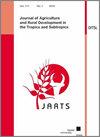Understanding the emergence and evolution of pastoral community groups from the perspective of community members and external development actors in northern Kenya.
Q3 Social Sciences
Journal of Agriculture and Rural Development in the Tropics and Subtropics
Pub Date : 2018-01-01
DOI:10.17170/KOBRA-2018121865
引用次数: 1
Abstract
Whereas there is abundance of information on community groups that engage in income generation in rural agricultural and peri-urban areas, information on community groups in pastoral areas still remains scarce. However, in the recent past, a growing trend of such groups has been observed in the pastoral areas in northern Kenya. This study therefore explores how these groups have emerged since Kenya’s independence in 1963 to date, and which factors have contributed to their evolution. A full survey on all income-generating community groups was conducted and different types of interviews were used to elicit the perspectives of members of the community and external development actors. The findings on the history of group formation show the roles played by different entities over time and reveal how and why various factors influenced group formation. The characterisation of all 153 income-generating groups found in Marsabit South showed the diversity of the different group activities and yielded information on the reasons why usually a combination of different income-generating activities is practised. The collective group activities offer a possibility for income diversification for pastoralists despite labour constraints posed by key domestic and livestockmanagement tasks. The findings explain why community groups are increasingly gaining importance in pastoral areas, as a means to solve problems and fulfil diverse needs at household and community level.从社区成员和外部发展行动者的角度理解肯尼亚北部牧民社区群体的出现和演变。
虽然关于在农村农业和城郊地区从事创收活动的社区群体的资料很多,但是关于牧区社区群体的资料仍然很少。然而,在最近的过去,在肯尼亚北部的牧区观察到这种团体的增长趋势。因此,本研究探讨了自1963年肯尼亚独立以来这些群体是如何出现的,以及哪些因素促成了它们的演变。对所有产生收入的社区群体进行了全面调查,并利用不同类型的访谈来征求社区成员和外部发展行动者的观点。关于群体形成历史的研究结果显示了不同实体随着时间的推移所扮演的角色,并揭示了各种因素如何以及为什么影响群体的形成。在南马萨比特发现的所有153个创收群体的特征显示了不同群体活动的多样性,并提供了关于为什么通常将不同的创收活动结合起来进行的原因的资料。尽管主要的家庭和牲畜管理任务造成劳动力限制,但集体活动为牧民提供了收入多样化的可能性。这些发现解释了为什么社区团体在牧区越来越重要,作为解决问题和满足家庭和社区层面多样化需求的一种手段。
本文章由计算机程序翻译,如有差异,请以英文原文为准。
求助全文
约1分钟内获得全文
求助全文
来源期刊
CiteScore
2.30
自引率
0.00%
发文量
0
审稿时长
>36 weeks
期刊介绍:
The Journal of Agriculture and Rural Development in the Tropics and Subtropics publishes papers dealing with original research and review papers in the fields of plant production, animal nutrition and animal husbandry, soil science, rural economy and farm management, forestry and forest economy, veterinary hygiene and protection against epidemics.

 求助内容:
求助内容: 应助结果提醒方式:
应助结果提醒方式:


